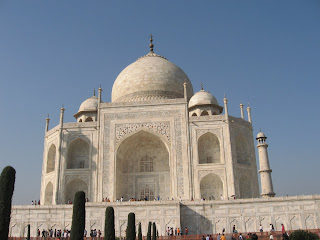 Finally, we come to our last stop, Jaipur, known as the "pink city" in the Indian state of Rajasthan. Most of the chief sights in this city date from the 18th and 19th centuries, when a series of maharajas decided to showcase their wealth from mineral deposits and precious stones in the area. First is the Jantar Mantar, an unusual observatory built by a maharaja who was an amateur astronomer. Many of his devices are still accurate today.
Finally, we come to our last stop, Jaipur, known as the "pink city" in the Indian state of Rajasthan. Most of the chief sights in this city date from the 18th and 19th centuries, when a series of maharajas decided to showcase their wealth from mineral deposits and precious stones in the area. First is the Jantar Mantar, an unusual observatory built by a maharaja who was an amateur astronomer. Many of his devices are still accurate today.The City Palace, pictured below, was home to Jaipur's rulers through Indian independence. The interior contains many opulent rooms like the one pictured here.
On the outskirts of Jaipur is the hilltop Amber Fort, which tourists approach by riding on elephants (yes, I did). The second shot is of members of my group on the way up.
The Palace of the Winds is a whimsical addition by a later ruler who designed it so the ladies of his harem could observe the street below without being seen themselves.
Finally, here is a traffic scene in Jaipur's central square, showing the diverse modes of transportation and the fact that traffic lanes are mere suggestions. As one driver told me, you need three things to drive in India: good horn, good brakes, and good luck!
I left Jaipur very reluctantly on February 25 to begin the long journey home, which took some 34 hours from the Jaipur hotel to the Delhi airport (5 hours drive with another 5 before my flight), then nonstop to Chicago (15 hours), plus a 4 hour layover and and 4 hour flight to LA and another hour before reaching my own house in LA. Fortunately I was able to sleep on the long flight (which I usually don't), but you'll understand why it took some two weeks to fully recover from my jet lag.







































